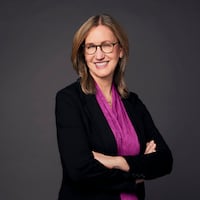Northside Hospital Inc. paid its CEO more than $3 million in 2016 — a total compensation package that placed him well above most of his peers. Northside’s longtime CEO even made more than the chief executive of the renowned Mayo Clinic in Minnesota.
How does he earn the bonuses and other payments that bump up his pay? The hospital won’t say, and it refused The Atlanta Journal-Constitution’s request to review its leader’s employment contract and bonus plan documents.
Its refusal is the latest chapter in a long-running legal dispute about whether the healthcare system — whose flagship hospital is a publicly-owned facility — is required to be more open and transparent than it is. While the court fight over this issue moves into its sixth year, the debate about whether Georgia nonprofit hospitals can keep their business dealings secret is about to play out on a completely different stage: the Gold Dome.
A powerful group of state lawmakers appears concerned about the secrecy and business practices of some nonprofits that operate Georgia hospitals, especially the nonprofits that run hospitals owned by public hospital authorities.
A report last month by 26 House members calls for legislation that would mandate charity care levels for nonprofit hospitals and require the hospitals to disclose the value of their tax exemptions. That would allow the public to find out whether the hospitals are getting more in breaks than they are giving back to their communities.
The report also calls for nonprofits to post executive salaries on hospital websites.
Lawmakers also want legislation saying that all operating subsidiaries of hospital authority-owned hospitals are subject to open records requirements.
This proposal comes when many hospitals in rural Georgia are losing money and some have closed. Meanwhile, some large urban hospital systems are posting huge margins and paying executives seven-figure salaries.
Rep. Terry England, R-Auburn, an influential legislator and co-chairman of the group of legislators that released the report, said a nonprofit hospital’s website should be filled with information on how much a hospital does to serve its community.
"The thing is, 95 to 99 percent of the hospitals are doing the community benefits and are doing exactly what they should be doing," England said, "but there are a few that are either not fulfilling the mission or they're doing it in a way that it was never intended for it to be."
Hospitals evolve
For years, many Georgia hospitals were run by their county hospital authority. The hospitals were built primarily with public money and managed by each authority’s board of political appointees. But as healthcare became more complex, many authorities needed more flexibility.
So, a generation ago, one public authority after another created nonprofit organizations to run their hospitals under long-term lease agreements. These days, patients often have no idea that their local hospital has public roots, but many do.
The WellStar Health System operates public hospitals in several counties, including its Kennestone facility in Cobb. Gwinnett Medical Center is owned by the public but operated by a nonprofit. In 1991, the Hospital Authority of Fulton County followed the trend and created the nonprofit Northside Hospital Inc. to lease the public hospital and carry out the authority’s mission.
Georgia courts soon ruled that these nonprofits were carrying out the business of government and were subject to the open records law. In recent years, though, Northside pushed back, concerned that its competitors could get an unfair edge. When a lawyer sued Northside in 2013 for its refusal to hand over documents on some business transactions, an intense court battle began.
For a while, Northside was winning. However, the Supreme Court of Georgia late last year reversed two lower court rulings that had favored Northside's refusal to turn over the records.
The Supreme Court's decision sent the case back to Fulton County Superior Court to determine whether the specific documents being requested — involving Northside's $100 million acquisition of large physician groups — had to be released.
But the state’s top justices rejected Northside’s argument that none of its records were subject to disclosure. Northside’s operation of its flagship hospital in Atlanta and other leased facilities that are owned by the public authority “is a service it performs on behalf of the (county’s) agency, and so records related to that operation are public records,” Justice Nels Peterson wrote.
CEO secrets
In October, nearly a year after this decision, Northside turned down the AJC’s request for its CEO’s contract and compensation documents, saying the nonprofit is not covered by the state’s sunshine laws and the documents are trade secrets.
The response surprised some open government advocates.
"It is astounding that Northside Hospital, after a unanimous decision against it by the Georgia Supreme Court in November 2017, continues to assert that it is not subject to the Georgia Open Records Act," said David Hudson, an Augusta attorney who represents the Georgia Press Association. He said it's hard to imagine a valid argument that the CEO compensation records aren't closely related to the operation of the leased public hospital.
Northside declined to be interviewed, but one of its attorneys explained its denial to the Georgia Attorney General’s office, saying in a letter, “No court has determined that any document [the AJC] seeks – or any other document in Northside’s possession – is subject to disclosure under the Act.”
While some hospitals readily provide documents — including CEO compensation plans — to the AJC and others when asked, Northside isn't the only hospital that pushes back. The Albany-based Phoebe Putney Health System, which includes the public Phoebe Putney Memorial Hospital, also declined the AJC's request. An attorney for the hospital said that the health system, unlike the hospital itself, is not carrying out the responsibilities of the local hospital authority. It cited a local court decision in 1998 that it said shielded the records from disclosure.
In its most recent IRS report, the health system reported paying $7.1 million in total compensation for CEO Joel Wernick, but said $5.5 million of the total was retirement compensation that had accumulated over years. Wernick’s base salary was $765,840.
While nonprofits must report their total compensation in their public IRS forms eventually, the AJC has repeatedly sought more detailed information. Without it, it’s impossible to know if hospitals reward the CEOs who oversee public hospitals solely on financial performance and growth, or whether quality and community service are also rewarded.
When the AJC asked Grady Memorial for its CEO’s contract and information about its bonus program, the hospital readily agreed, and Grady CEO John Haupert sat down with the AJC to discuss the plan. The WellStar Health System also provided the AJC with its CEO’s compensation documents. They show a detailed plan that uses measurements of employee trust and engagement, patient satisfaction and clinical quality. Financial measures made up just 20 percent of the bonus plan.
Making millions
Georgia’s lawmakers aren’t just worried about transparency. They said in their recent report that the state’s health care system needs to be “revolutionized” so Georgians can get the care they need.
Six rural Georgia hospitals and two state psychiatric facilities have closed since 2011, said Ethan James, the Georgia Hospital Association’s lobbyist. Two other hospitals have closed emergency departments, and many others have discontinued labor and delivery services, he said.
The AJC found that about 45 percent of Georgia hospitals reported losing money in 2017, according to financial reports filed with the state. But the reports also show something else: Some of the state’s large hospitals are doing better than ever.
At Northside’s flagship in Fulton County, margins increased from $41 million in 2010 to more than $327 million in 2017, the AJC found. The margin is basically a measure of “profit” — how much a facility made in revenues beyond all of its expenses. The figures only include revenues and expenses inside the hospital, not outpatient services or a hospital’s primary care offices.
While Northside Atlanta has the highest margin among Georgia hospitals in terms of the dollar amount, the AJC found a number of other hospitals brought in at least $100 million more than they paid out in expenses. Those included WellStar Kennestone, both the Egleston and Scottish Rite hospitals operated by Children's Healthcare of Atlanta, Piedmont Hospital in Atlanta and Emory's flagship on the Emory University campus.
James, of the Georgia Hospital Association, said Georgia needs hospitals that are prosperous. Their resources allow them to partner with hospitals that struggle, while also providing ground-breaking care and research that can benefit all Georgians, he said.
Northside said its success is good for patients. “Our growth and financial stability enable us to provide high quality health care promptly and efficiently,” spokesman Lee Echols said in a statement.
Part of what lawmakers are seeking with their proposal is to make sure that all nonprofit hospitals are doing their part. Hospitals vary in the amount of indigent and charity care they provide. At WellStar Cobb Hospital, this uncompensated care accounted for more than 18 percent of its adjusted gross revenues in 2017, according to the Georgia Department of Community Health. At WellStar Kennestone, it was nearly 13 percent. At Grady Memorial Hospital, it was 30 percent.
Northside Atlanta did 7 percent, according to the state figures. Piedmont Atlanta and Emory University Hospital were less than 5 percent.
Charity care
Grady Memorial Hospital has always found a way to provide care to the neediest. Faced with its own financial crisis, Grady in 2008 adopted the nonprofit model that other Georgia hospitals embraced years earlier. The hospital authority created Grady Memorial Hospital Corp., a change that allowed it to raise millions in private donations and put Grady on solid financial footing.
Pete Correll, former CEO of Georgia-Pacific and a dean of Atlanta’s business community, was the inaugural chairman of that nonprofit board.
Correll, who now heads the hospital’s foundation board, said converting to a nonprofit was critical for Grady and necessary for most hospitals. But he said transparency and accountability were preserved in Grady’s switch. The lease agreement states that the nonprofit is subject to open records requests, he said.
While this nonprofit hasn’t wavered on its mission, Grady’s CEO John Haupert knows that most of the nonprofit hospital executives across the country work in an intensively competitive business. “They’re all in a battle for the next fully insured patient,” Haupert said. That’s because Medicare and Medicaid rates are so low, he said, that privately insured patients have to pay more to cover the gap.
Haupert said Grady’s board sets goals for him, and the entire organization, that keep Grady focused on its mission. “If you always put the patient at the center of that, then you will always make the right decisions,” he said.
Correll said it makes sense for the General Assembly to push some other nonprofits to do more to serve their communities. If the statistics show a nonprofit is dedicating only a tiny part of its work to charity care, then he said the state should act.
“They need to say there is some minimal level of charity care that you must do to qualify for being a not-for-profit,” he said.
WHY IT MATTERS
With nearly half of Georgia’s hospitals losing money and some closing in recent years, the AJC is taking a close look at the nonprofit organizations that run hospitals owned by the public. Access to quality healthcare is important to every Georgia resident, but it’s not easy to find for some Georgians — especially those who lack insurance coverage. Some nonprofit health systems are making more money than ever, but are they giving enough back to their communities? A group of Georgia lawmakers wants nonprofit hospitals to disclose more information about what they pay their executives, and they believe it may be time to require nonprofits to provide a set amount of charity care in exchange for the tax benefits nonprofit hospitals receive.
While many Georgia hospitals are losing money, some large hospitals in urban areas are prosperous. The latest financial reports filed with Georgia health officials show that a number of Georgia hospitals had margins — similar to a profit — of $100 million or more. These figures only represent hospital operations. Hospitals say they often support other parts of their healthcare system with the money they make at their hospitals. Nonprofits must invest their “profits” back into their operations.
Here are some of Georgia’s most prosperous hospitals in 2017.
Hospital, Operating Margin, Margin Percent
- Northside Hospital Atlanta, $327 million, 17.9%
- WellStar Kennestone Hospital, $244 million, 24.9%
- Children's Healthcare-Egleston, $190 million, 28.5%
- Northeast Georgia Medical Center, $163 million, 17.3%
- Children's Healthcare-Scottish Rite, $152 million, 26.2%
- Piedmont Atlanta Hospital, $138 million, 14.9%
- Doctors Hospital of Augusta, $119 million, 30%
- Emory University Hospital, $116 million, 13.4%
Source: Georgia Department of Community Health, Hospital Financial Survey Revenue Report
Note: Margin represents net revenues minus total expenses.
.
.
WHY IT MATTERS
With nearly half of Georgia’s hospitals losing money and some closing in recent years, the AJC is taking a close look at the nonprofit organizations that run hospitals owned by the public. Access to quality healthcare is important to every Georgia resident, but it’s not easy to find for some Georgians — especially those who lack insurance coverage. Some nonprofit health systems are making more money than ever, but are they giving enough back to their communities? A group of Georgia lawmakers wants nonprofit hospitals to disclose more information about what they pay their executives, and they believe it may be time to require nonprofits to provide a set amount of charity care in exchange for the tax benefits nonprofit hospitals receive.
While many Georgia hospitals are losing money, some large hospitals in urban areas are prosperous. The latest financial reports filed with Georgia health officials show that a number of Georgia hospitals had margins — similar to a profit — of $100 million or more. These figures only represent hospital operations. Hospitals say they often support other parts of their healthcare system with the money they make at their hospitals. Nonprofits must invest their “profits” back into their operations. Here are some of Georgia’s most prosperous hospitals in 2017.
Hospital, Operating Margin, Margin Percent
Northside Hospital Atlanta, $327 million, 17.9%
WellStar Kennestone Hospital, $244 million, 24.9%
Children’s Healthcare-Egleston, $190 million, 28.5%
Northeast Georgia Medical Center, $163 million, 17.3%
Children’s Healthcare-Scottish Rite, $152 million, 26.2%
Piedmont Atlanta Hospital, $138 million, 14.9%
Doctors Hospital of Augusta, $119 million, 30%
Emory University Hospital, $116 million, 13.4%
Source: Georgia Department of Community Health, Hospital Financial Survey Revenue Report
Note: Margin represents net revenues minus total expenses.
About the Author
The Latest
Featured






